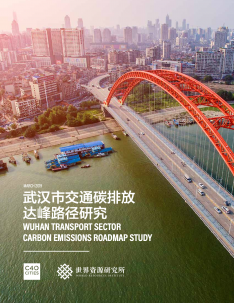Wuhan Transport Sector Carbon Emissions Roadmap Study
Active commitments and actions at the sub-national level are in place to support carbon emission reduction to reach the 2°C or 1.5°C goal of the Paris Agreement. At the first U.S.-Sino Climate Smart/Low-carbon City Summit in 2015, Wuhan announced it would aim to reach peak city-wide all sector-combined CO2 emissions by 2022, and then carried out a city-wide emissions scenarios analysis. To reach the peak of city-wide CO2 emissions relies on the efforts from all sectors, including industry, energy, building, and transport sectors. Therefore, Wuhan proposed to further study the emission roadmaps of different sectors. This report focuses on Wuhan’s transport sector, analyses and predicts the level of CO2 emissions from different modes of transport between 2005-2050, and provides recommendations for low carbon transport development in Wuhan.

The transport sector currently accounts for around 10% of carbon dioxide emissions in Wuhan, China. Accelerating urbanisation and increasing transport demand from the commercial and residential sectors in the city will continue to increase emissions rapidly over the coming years. If Wuhan’s development continues to be dominated by automobiles and fossil fuel-based transport, traffic congestion, air pollution, and greenhouse gas emissions will become more serious problems.
If appropriate environmental measures are implemented, the analysis shows it is possible for carbon dioxide emissions from Wuhan’s transport sector to reach their peak in 2029. With the right changes, the level of emissions from road-based vehicles and the subway system could peak sooner, in 2025. In order for Wuhan to meet its commitment of peaking city-wide all-sector combined emissions in 2022, more ambitious low-carbon actions should be taken in other sectors, including the industrial and building sectors.
Policy and actions that promote greater use of electric vehicles and public transport have the potential to bring the greatest reduction in emissions, along with increasing fuel efficiency and clean electricity, optimising freight distribution networks, and building capacity in data management and monitoring.
Cleaning up Wuhan’s carbon emissions will require action by both the city administration and the private sector.
Projects

Sustainable Mobility
Visit ProjectSustainable Mobility Project aims to contribute to the development of low-carbon transportation in China, and build a green, efficient, inclusive and resilient urban mobility system.
Part of Sustainable Cities
Low-carbon transport
Visit ProjectWe work with national and local partners to develop medium- and long-term transport decarbonization roadmaps, formulate near-term key emission-reduction solutions, and facilitate global knowledge sharing, to achieve the low-carbon transition of China’s transport sector while ensuring social equit
Part of Sustainable Cities
